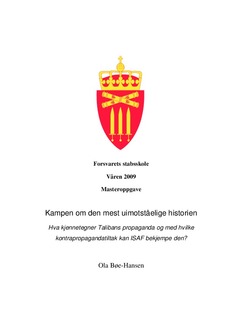| dc.description.abstract | This analysis is split into two where the first half is dedicated to what characterizes Taliban propaganda, and the other half to an analysis of which counterpropaganda measures ISAF can utilize in order to counter it. The Taliban’s propaganda apparatus has grown in size, skill and emphasis since it was removed from power in late 2001. It has shown ability to adapt to modern media and technology, and can now communicate with a global reach and impact. Their messages are mostly based on real incidents, but often strongly exaggerated. They use strong religious connotations to harvest authority and legitimacy. The civilian population is deliberately used as human shields, which has lead to incidents where ISAF operations cause civilian casualties, giving Taliban propaganda opportunities. They utilize their knowledge of the people’s culture, history, traditions and language. They have also learned weaknesses within their enemy and the paramount role of the news media. The Taliban is an actor that efficiently exploits the physical battle domain to support the decisive cognitive domain. Three cases of Taliban propaganda are being discussed in this thesis; Mullah Mohammad Omar’s Eid Messages, how the Taliban utilizes spectacular incidents, and exploiting incidents where ISAF causes Civilian Casualties. The main ISAF counterpropaganda contributions identified here are supporting the legitimacy of the Afghan Government, supporting the security situation on the ground, improving the legal framework for treatment of prisoners, condemning the Taliban’s use of young men as suicide bombers, offering preventive measures against suicide bombers, turning the Taliban’s violence (documented by the UN) against them, sustain media readiness in order to being first with the truth and other relevant information, and communicating objectives and intentions to the population to give them a feeling of comprehensibility. The analysis, the interviews and the theoretical framework all pave the way for a focus on the population. Efforts must be prioritized on the cognitive domain in order to have effect in countering the Taliban propaganda. The non-kinetic efforts must be supported by kinetic efforts on the ground in order for the population to be receptive of an anti-Taliban posture. This clearly identifies the close links between kinetic and non-kinetic military operations, and the need for an overarching narrative – the most compelling story. | en_US |
